|
|
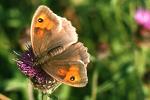
|
Meadow Brown
|
|
Special features: The male (top) is slightly smaller than the female, and dark brown all over. The male has one black 'eye' spot on each forewing. The female has large orange patches and an eye spot on each forewing. |
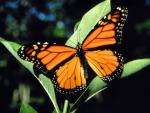
|
Monarch
|
|
Special features: The Monarch butterfly is a rare migrant, most likely from America, since most sightings occur on the west coasts of Britain. If they are from America it's likely they get blown off course on their annual southerly migration to Mexico. |
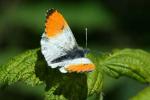
|
Orange Tip
|
|
Special features: Both male and female orange tip butterflies have white wings. Only the males have the bright orange colouring on the wing tips. The females have grey wing tips. The females look very similar to small white butterflies, but the small whites lack the mottled markings on the undersides of the hind wings. |
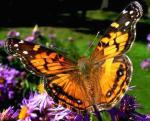
|
Painted Lady
|
|
Special features: The painted lady is a summer visitor to Britain. It travels several hundred miles to get here from the north coast of Africa and the south coast of France. They come here for the plentiful supplies of fresh nectar, and also to breed. |
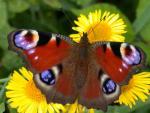
|
Peacock
|
|
Special features: Peacock butterflies can be easily recognised by their four large eye spots, which look similar to those on a peacocks tail feathers. |
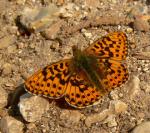
|
Pearl-b Fritillary
|
|
Special features: The Pearl-bordered Fritillary name comes from the markings on the undersides of the hind wings. The outside edge has a row of seven silvery-white spots which resemble a string of pearls. |
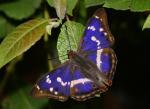
|
Purple Emperor
|
|
Special features: The iridescent purple colouring is only seen on the male. The female has brown wings with brighter white patches. Both the male and female purple emperor have eye-spot markings on the undersides of the wings. |

|
Purple Hairstreak
|
|
Special features: The upper surfaces of the wings have an iridescent purple sheen, but you only get to see this when they are flying. At rest the wings are closed and the undersides of the wings are a silver-grey. The undersides also feature the characteristic white 'hairstreak' line, and small eye markings near the 'tails'. |
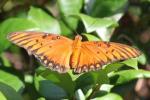
|
Q of S Fritillary
|
|
Special features: Queen of Spain Fritillaries are a rare visitor to the UK. The upper surface of the wings are orange with black markings. The photo above shows the male which has small green patches where the wings meet the body. The female has similar markings but with much larger green patches. |
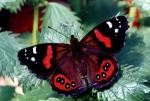
|
Red Admiral
|
|
Special features: The name admiral is a corruption of the word admirable which refers to its admirable bright colours. |
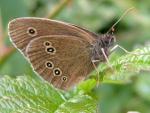
|
Ringlet
|
|
Special features: The male ringlet butterfly can be almost black when young, but fade to brown with age. The eye spots, or rings, which give this butterfly its name are very variable in size and shape. |
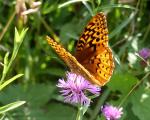
|
S W Fritillary
|
|
Special features: This is the largest Fritillary found in the U.K. |
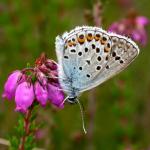
|
Silver-studded Blue
|
|
Special features: Male silver-studded blue butterflies are deep blue with an almost black border and white fringe. The females are usually brown with some orange spots at the edges of the wings. |
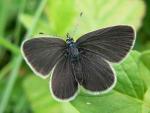
|
Small Blue
|
|
Special features: The Small Blue butterfly is the smallest butterfly in the UK. The upper surfaces of the wings are a dark smoky-brown colour. The males usually have a tinge of blue scales where the wings meet the body (but not always). |
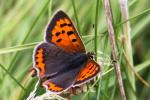
|
Small Copper
|
|
Special features: The small copper is named after its bright copper coloured forewings, which are dotted with black spots and have a black border. |
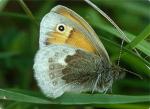
|
Small Heath
|
|
Special features: Looks like a miniature meadow brown. The colouring of the eye spots on the wings can be very variable. |

|
Small Skipper
|
|
Special features: The small skipper is a uniform orange-brown all over, but the males have a dark stripe running across their forewings. The club shaped ends of the antennae are black on top, and orange-yellow underneath. |
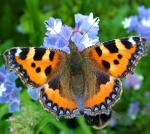
|
Small Tortoiseshell
|
|
Special features: This is one of the prettiest, and fortunately one of our commonest butterflies. They're resident in Britain all year, and can be found almost anywhere. |
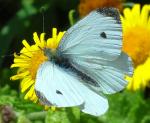
|
Small White
|
|
Special features: Sometimes called the 'cabbage white', the small white is one of our commonest species of butterfly, found in most areas except the highlands of Scotland. |
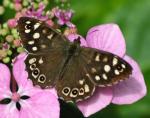
|
Speckled Wood
|
|
Special features: These butterflies tend to be found, as their name suggests, in woodlands. They are normally seen fluttering in the shafts of sunlight which penetrate through the woodland canopy. |

|
Swallowtail
|
|
Special features: It would be difficult to confuse the swallowtail butterfly with any other. It's one of the prettiest and certainly the largest butterfly found in the UK. |
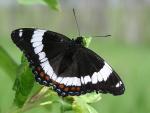
|
White Admiral
|
|
Special features: Nectar from bramble flowers are a favourite food, but the females lay their eggs on honeysuckle leaves, the caterpillars food plant. |
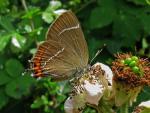
|
White-letter Hairstreak
|
|
Special features: The white letter hairstreak gets its name from the narrow white line on the underside of the wings which form a "W" shape. |

|
Wood White
|
|
Special features: The wood white is the smallest of the white butterflies. |
|
|